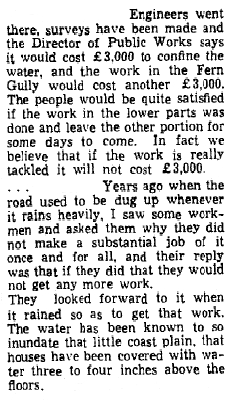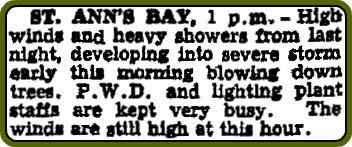At the start of the 1920s, Philip Sanford Marden,
an American travel writer of Lowell, Massachusetts,
wrote at some length in his book, Sailing South (1921),
of the drive through Fern Gully.
p 268-70 As we drew near the coast the road took a headlong plunge of three miles or thereabouts, down and ever
downward, through caverns seemingly measureless to man, the sides of which were covered with ferns of
most stupendous size and endless variety. Not the least interesting of Jamaican flora are the varieties of
fern. They embrace innumerable species. Your driver, whatever else he may not know, is anxious to show
you his knowledge of such things as these. "See, Missy! Silver fern! Wait! I get him for yo'." And forthwith he jams on his emergency brake, vanishes
over the side, and disappears in the undergrowth. Shortly he emerges with a few fern leaves, which you lay
on the back of your hand and then administer a smart blow. Behold! An exact reproduction of every frond
remains outlined in silver on your sunburned flesh. Or maybe in gold, if it's a gold fern. And as for sensitive
plant what they call locally '"Shamed of you" it is everywhere. Touch it and it shivers and shrivels into
itself, for all the world as if alive and very much frightened, thus to remain for about ten minutes by the
watch. Then it plucks up heart and opens again. The drive down to the sea, at a place still bearing the name of Ochos Rios (Eight Rivers) for some reason
which we did not discover, is known somewhat unpoetically as the "Fern Gully Ride." I never fancied the
word "gully." To me, it means a bleak and stony ravine, quite different from this opulent fern-clad abyss,
from the bottom of which we could hardly see the sun. We ground our way down through the verdant gloom of that cleft in the primordial rocks, pausing prudently
after a time to let the brakes cool sufficiently to save them, and always exclaiming at the beauty of the
environment, which was notable alike for its ferns, its depth of shadow, and its precipitous walls which
vanished somewhere above into an unguessed heaven of tropical trees. Then almost without warning we emerged from the gulf of ferns, and lo, there was the sea beating in long,
regular rollers on the palm-clad beach. A brawling stream, doubtless one of the eight, dashed out of the
jungle and with one exulting, joyous bound leaped into the arms of Ocean. East and west under the palms
stretched the white road that circles the island. Inland, the cliffs rose boldly.

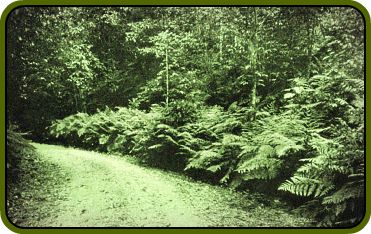
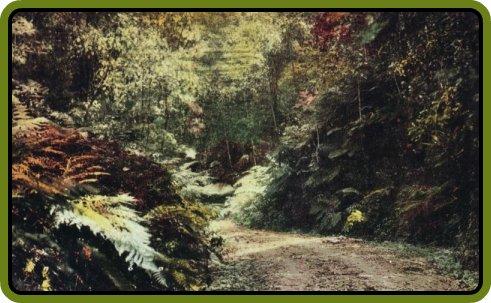
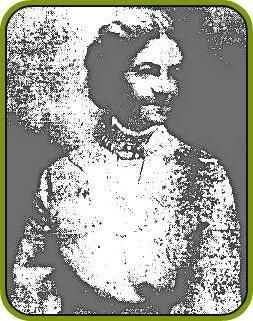
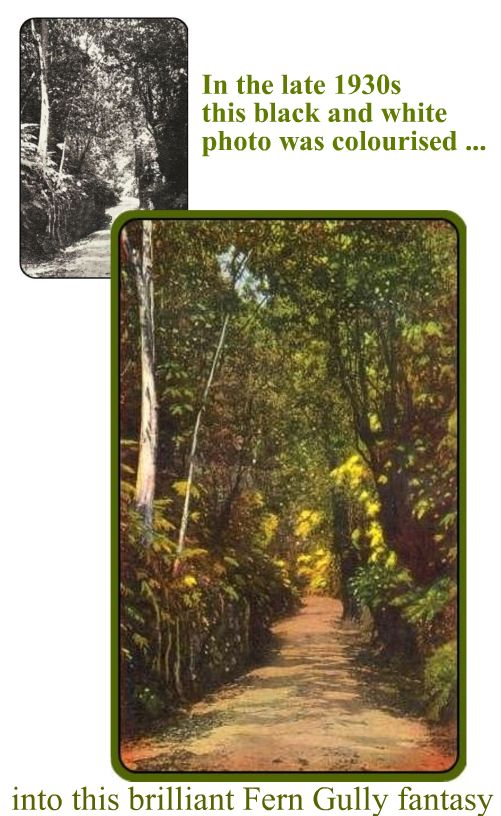
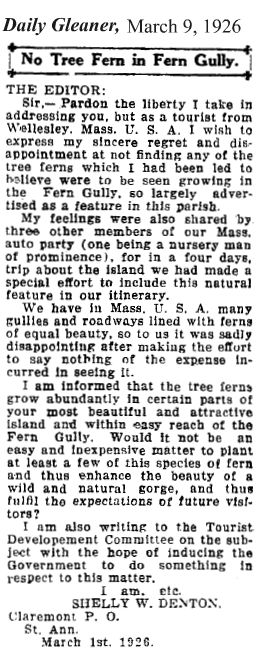

Daily
Gleaner, August 22, 1931
A
charming little lady in the person of Miss Lois Palmer, is
responsible for the high tone of the decorative work within the pages
of The Ladies Home Journal, and just at this time she is very happy
in spending a few days in Jamaica. Arriving by the S.S. Metapan on
Monday morning last from New York, on what is her first visit to the
Island. Miss Palmer has since been to Castleton and Hope Gardens, Bog
Walk and other points, and on Thursday, journeyed down to the
beautiful Fern Gully in the Garden Parish.
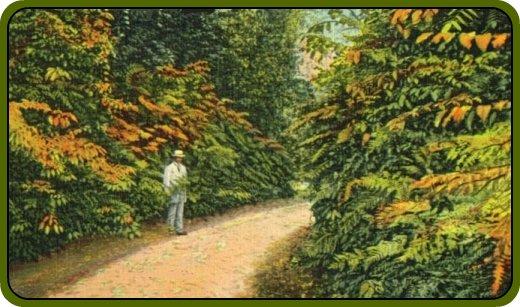
Seen by a representative of the "Gleaner" at the Myrtle Bank Hotel last night, Miss Palmer was all over in smiles at the thought of the five happy days past. "Fern Gully is so much like Devonshire, England," she said, "I just couldn't believe that the country place was so beautiful."
"When I went down to Fern Gully on Thursday, I thought that one of the most beautiful trips one could desire. . .”
[Hon G. S. Ewen, Trelawny in Leg Co]
He wondered if the Government knew that they had certain legal rights with regard to the Fern Gully in St. Ann. As a matter of fact, the Government had an encumbrance on titles with regard to lands adjacent to the Fern Gully. The object of this was to prevent denudation; and he was astonished to find the destruction which had taken place in the Fern Gully. It showed that there was a lack of interest with regard to the Department responsible for the Fern Gully. He did not know which department was responsible, whether it was the Colonial Secretary's Department, the Director of Public Works or the Lands Department. The fact remained that there was gross neglect on the part of those responsible. He agreed that if thev did something with regard to the route of the river from Bog Walk the would be doing something which was necessary (hear. hear). If he had known about the Government's position with regard to the Fern Gully he would have taken up the matter some time ago. 'Therefore if the Government took on obligations in the matter they should perform those obligations better than they had done in the past. Their scenery had a good deal to do with their tourist trade and he agreed that they should do everything possible to maintain the beauty spots of the island.

Daily
Gleaner, May 8, 1936
Mr.
Little [MLC St Ann in Leg Co] . . . . desired to ask the Hon.
Nominated
Member about public gardens. He understood
that
there was an arrangement for the
Agricultural Department to
look after the
ferns in Fern Gully. He was not sure
that there was
any improvement with regard
to the position. He would like to
hear what was done.
The
Director of Agriculture said that the care
of the Fern Gully
remained under the charge of the Director of Public Works.
Mr.
Little pointed out that there was a
strong recommendation
that the Agricultural
Department should look after the care of
the Fern Gully and he thought that the
recommendation was
accepted. He did not
think that the Public Works Department was the Department to look after the Gully.
It was concerned
about widening the road and matters in connection with traffic
but
a strip of land was acquired from the owners to improve the
Gully as it was
considered a landmark of the colony and
visitors
went there sight-seeing. They
had heard that the ferns were
destroyed
and that was why there was a
recommendation to
have the care of them
transferred from the Public Works
Department
to the Agricultural Department. He understood that
the number of variety of ferns
that were there for some years
was
being reduced and
that went to show that there was lack
of
proper care. They should not allow that to continue.
CHANGED VERY RAPIDLY
The
Director of Agriculture said that he joined
with the
Honourable Member for St. Ann in urging that they should
preserve the
beauty of the Fern Gully. But after
periods of dry
weather dead leaves were
strewn in the Gully. But the position
soon changed very rapidly after rains.
The
principal work in looking after the Gully
was the clearing
away of those leaves
and the general care
of the Gully. The
protection of the
Gully, as desired by the Honourable Member
for St. Ann would
involve somebody resident there to look
after
it. But he was not aware that
Government was prepared to meet
that expenditure at that stage.
He
had been through the Gully recently and
officers of the
department when going to
other districts passed through there
and reports were frequently made with regard to its condition.
He
thought members would be satisfied when he
said that every
effort waa being made
that the Gully should remain one of the
beauty spot of the island and there was the wish of seeing it
preserved.
Mr.
Little said that was not practical: he
wanted to know whether
it would be left to the Public Works Department or the Agricultural Department.
WILL KEEP AN EYE
The
Director of Agriculture stated that the
Agricultural
Department had been instructed to keep an eye on it.
teacher and politician
MLC St Ann, 1935-42

Heavy damage to roads was done in St Mary, St. Ann, St James and Hanover by the flood rains which were experienced over the week-end. Traffic has been paralysed in certain sections, but the Public Works Department are rushing restoration work.
The road between St Ann's Bay and Claremont was blocked by landslides on Sunday night but these have been cleared and the road is now passable to traffic. The Fern Gully road has been washed out and blocked to traffic. The road between St. Ann's Bay and Ocho Rios is inundated and impassable in several sections. The township of Ocho Rios is cut off but it is understood to be under water.
THE EDITOR
Sir,- In view of the frequent and sometimes unjust criticisms which are levelled at the officers of the P.W.D., I should like to reverse the order of things and give a word of praise to the Superintendent of the P.W.D for St Ann and his Staff for the efficient and quick manner they handled the flood damage done on the Fern Gully Road leading to Ocho Rios.
As the result of the recent flood rains this road was a mass of small ravines and huge boulders, and in a few days the damage was put right and the road made safe for traffic In fact as the result of the use of a steam-roller, the surface of the road is now better than before the rains.
I am, etc,
K M. PRINGLE.
Shaw Park Hotel,
Ocho Rios,
November 27, 1937.
At
Ocho Rios the bridge at Milford has been completed, for which I must
express pleasure, but there is still the river training work. The
difficulty at that town (though it is treated as a village it is a town),
is that the water comes off the Fern Gully and is let loose and
scattered into the town forming at certain seasons a large and very
dangerous swamp. The information is that years ago, there was a
ravine that took away the water, but the story is that the metal
placed by the Public Works on the road was washed off by the rain and
gradually levelled up the place until the water has no definite course to the sea.
one explanation for the ongoing failure to correct that situation:
